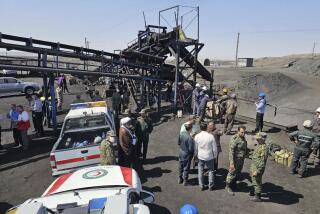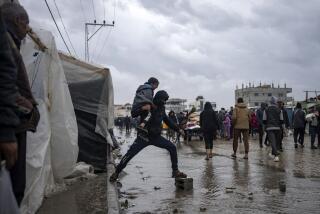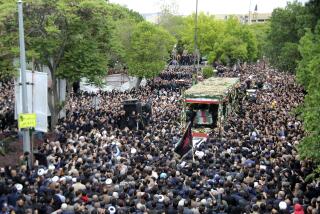Iran Quake Toll Reaches 29,000 : Disaster: International help pouring in to devastated region. The Red Cross says 400,000 may be homeless.
TEHRAN — International rescue and medical teams poured into the Iranian capital Friday as rescue workers and dazed survivors struggled to dig thousands of dead and injured from the rubble of the devastatingly powerful earthquake in northwest Iran and the official death toll rose to nearly 29,000--the highest for an earthquake in 14 years.
A dozen towns and hundreds of villages were devastated by the temblor that spread across two provinces of a broad agricultural region near the Caspian Sea early Thursday. The Red Cross in Geneva, quoting the Iranian Red Crescent Society, said about 400,000 people are believed homeless.
Iran’s official Islamic Republic News Agency (IRNA) reported Friday that the known dead number 28,950. It said 25,241 bodies have been counted in Gilan province, on the Caspian Sea, and 3,709 in Zanjan province. That toll surpasses the 25,000 killed in Soviet Armenia in December, 1988, and is the highest known worldwide since July, 1976, when an earthquake in China reportedly killed 242,000.
The U.N. Disaster Relief Organization in Geneva said it was told by the Iranian Foreign Ministry that the death toll is expected to reach 35,000, with 105,000 people injured. A total of 28,198 people were injured in the two provinces, IRNA said.
More shocks followed the big quake. Interior Minister Abdullah Nouri said a main road in the disaster zone, cleared Thursday, was blocked by a fresh landslide Friday, wire services reported.
President Hashemi Rafsanjani visited the hardest-hit area, including the town of Roudbar in the Caspian province of Gilan. He said “nothing worth mentioning” was left of towns and villages he saw during a helicopter flight over the quake zone. Gilan province and adjoining Zanjan have a population of about 4 million people.
He told reporters that Iran, proud of its self-reliance since Ayatollah Ruhollah Khomeini’s 1979 Islamic Revolution, would accept foreign help for quake victims.
“The catastrophe is so serious . . . “ Rafsanjani told IRNA. “International help is needed. We should accept the help that is offered.”
However, Iranian authorities appeared to vacillate Friday between welcoming the outside help--including representatives from countries with which Iran has a hostile relationship--and rejecting it as unnecessary.
Four of Iran’s bitter enemies--the United States, Israel, Iraq and Saudi Arabia--sent offers to help. In Washington, State Department officials said the U.S. government is donating about $300,000 worth of supplies to the American Red Cross for shipment.
The first team to arrive in Tehran from the international medical relief organization, Medicins du Monde, was blocked from entering the main earthquake area by authorities.
“My biggest fear is that we will not be allowed to work,” said Dr. Jean Porrini, leader of the 12-person unit that included a surgical team. “We are getting very contradictory information from the ground. The first team we sent in was apparently blocked.”
Disaster specialists from France, Switzerland, Belgium and Britain arrived late Friday night on commercial flights and special charters. They carried equipment ranging from a complete field surgical theater to satellite communication discs. Several arrived with dogs specially trained to sniff through rubble for the trapped victims.
Some rescuers such as a 17-member International Rescue Corps of Marlow, England, brought sophisticated heat-sensing and sound detection equipment that the Iranians do not have.
The International Rescue Corps team from England brought its own satellite transmission system after encountering serious communication problems working in Armenia during the earthquake there last year. However, although they were sponsored on the trip to Iran by an agency of the United Nations, team leader Bryan Kirby said Friday he was not sure the group would be allowed to set up in Iranian territory.
“We would like to work tonight if they would let us,” said Kirby, “but we haven’t been able to get any reliable information. We have casualty estimates of from 1,000 to 37,000 dead over a wide area of Iran.”
One crowded commercial flight to the Iranian capital from Paris was filled with worried Iranians hoping to find their families.
“I was sitting in my hotel room in Paris and saw the home where I was born completely destroyed,” said one Iranian man. “I was horrified, but what could I do?”
Rafsanjani said the greatest need is for heavy equipment--especially cranes to lift huge pieces of rubble.
Iran told the Swiss-based League of Red Cross and Red Crescent Societies that it needs medicine, tents, blankets, food, trucks, cranes and bulldozers. It said it does not need doctors and other experts or blood supplies, sniffer dogs or used clothing.
Iranian television showed doctors tending victims on stretchers in a makeshift hospital in a parking lot. Masked rescuers in white aprons pulled dust-covered bodies from under concrete slabs. Corpses were laid on blocks of ice in open trucks.
Television showed scenes of devastation, including the remains of an entire row of hillside village houses that collapsed and slid down the hill.
Rescuers scooped up rubble and used police dogs to find victims. They gently fed water to one man who was trapped in a mass of stones and earth, only his head protruding.
At Manjil in Gilan province, Parvin Nemati clutched the headless body of one daughter wrapped in a blanket. Her husband and relief workers unearthed the body of another daughter, 10-year-old Fatemeh, an Iranian correspondent reported.
A man in Roudbar told Iranian television “a rock as big as a building” crashed into his home, killing four of his six children. His wife said she lay in the ruins for hours with one of the surviving children beside her.
“There is not a single house in this area which has been left standing,” farmer Ali Mohammadi said in Roudbar.
Television showed villagers looking at houses turned into heaps of mud bricks and wooden beams by the quake, which was measured at a magnitude of 7.3 by Tehran University; the U.S. Geological Survey in Golden, Colo., put it at 7.7.
Farhad Shad, a spokesman for the Geophysics Center at Tehran University, told IRNA that 140 aftershocks were registered after the main temblor.
Hospitals overflowed with victims. Tehran Radio said some of the injured were flown 600 miles from the disaster zone for treatment.
At the large Khomeini Hospital south of Tehran, a continuous line of ambulances drew up to the doors bearing victims from the earthquake. Doctors at the hospital said most of the victims suffered crushed bones and head injuries.
A young mother hovered over her pale 4-month old baby.
“The baby was asleep with my husband when the earthquake started. I grabbed him and started to run outside, but a wall fell on us and crushed his head,” she said.
The attending doctor said the young baby girl, Nadia, had suffered multiple fractures of her skull and that her intelligence would probably be impaired as a result.
Fourteen of the hospital’s physicians had been dispatched to the earthquake area itself.
Tehran airport was thronged with people trying to reach the quake zone to learn the fate of relatives. Officials turned them back, saying the planes were needed for relief workers.
This report was supplemented with reports from Times wire services.
More to Read
Sign up for Essential California
The most important California stories and recommendations in your inbox every morning.
You may occasionally receive promotional content from the Los Angeles Times.










